In a world where capturing and retaining attention is harder than ever, QR Codes have emerged as a powerhouse for driving engagement. Once perceived as a simple information-sharing tool, QR Codes have undergone a remarkable transformation over the past few years, enticing brands and businesses of all sizes to embrace their potential for making more meaningful connections around the world.
QR Codes saw a surge in adoption during the global pandemic, but their place in the business landscape across industries has expanded. Since then, they’ve permeated the world with innovative applications popping up every day. From product packaging and subway ads to checking in at the doctor’s office and gaining entry to a live event, as businesses strive to understand their audiences’ preferences, knowing where and how they want to engage is key.
Background
To help businesses and brands of all sizes get a pulse on how the QR Code landscape has evolved, we created the Bitly QR Code Trends Report. As the world’s leading Connections Platform with over 520k global customers, we have an even more vibrant set of data to look at this year. We analyzed data from QR Code Generator, a Bitly product, as well as QR Codes on the Bitly Connections Platform to uncover key trends and consumer behaviors.
We looked at the relationship between geographies, industries, and engagement across QR Code creations and scans to understand the current landscape throughout the first two quarters of 2023. As expectations evolve, keep these insights handy so you can leverage QR Codes effectively and create more memorable experiences.
Trend 1: QR Code adoption soars globally
In 2023, global QR Code adoption soars with double-digit growth as brands and businesses recognize their value.
Over the past several years, we’ve seen businesses and brands increasingly adopt Bitly QR Codes to provide consumers with multiple options for connection that bridge the physical and digital worlds. Because of their convenience, efficiency, and measurability, businesses are leveraging QR Codes to drive stronger engagement, share information, and create a more seamless experience for consumers.
We see a strong upward trend in the creation of QR Codes since 2020, with a significant acceleration in 2021 and 2022, as the global pandemic inspired businesses of all sizes to reach and connect with consumers in new ways. In the first half of 2023, we’re seeing a 41% growth in global QR Code creations compared to the same period last year.
As QR Codes become a standard best practice for businesses of all sizes to spark connections with customers around the world, we expect to see adoption grow steadily over the coming years.
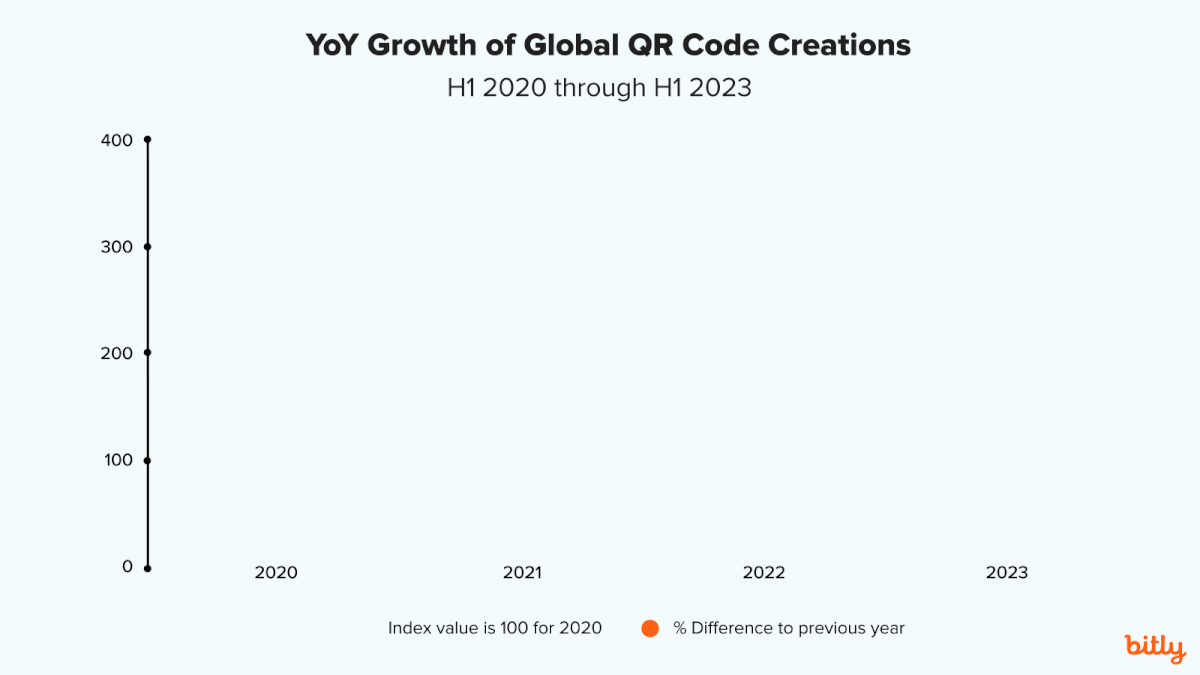
QR Code creations are booming around the world as significant growth carries over into the first half of 2023.
As we look deeper into QR Code creations through a geographical lens, we see substantial growth over the past year in the United Kingdom, Switzerland, and the United States, with Germany and France rounding out the top 5 countries for growth in 2023. We also see notable growth in Ukraine, which increased QR Code creations by 14x compared to the same period in 2022.
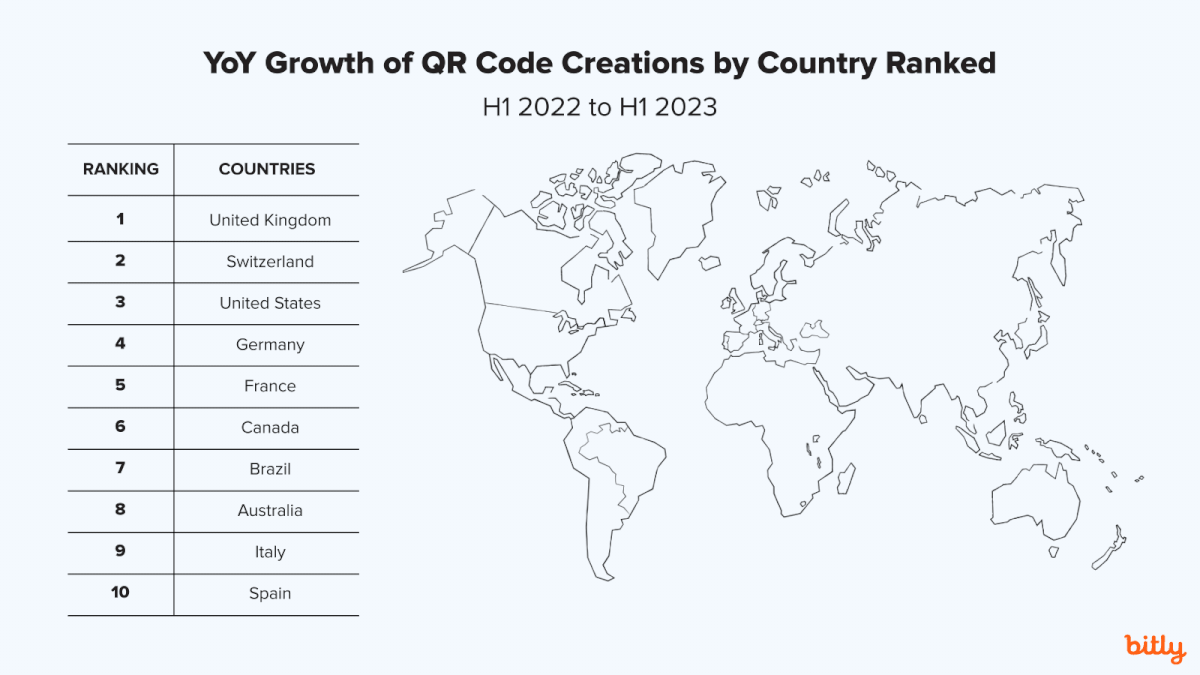
While the creation of QR Codes remains strong across these individual countries, there are also interesting developments when we zoom out and look at global trends across regions. According to our data, in the first half of 2023, we see new growth emerge in the Middle East and North Africa region (MENA) as well as in Latin America (LATAM) as the adoption and utilization of QR Codes gains momentum.
In the Middle East and North Africa region, QR Code creations surged by 66% compared to the same period in 2022.
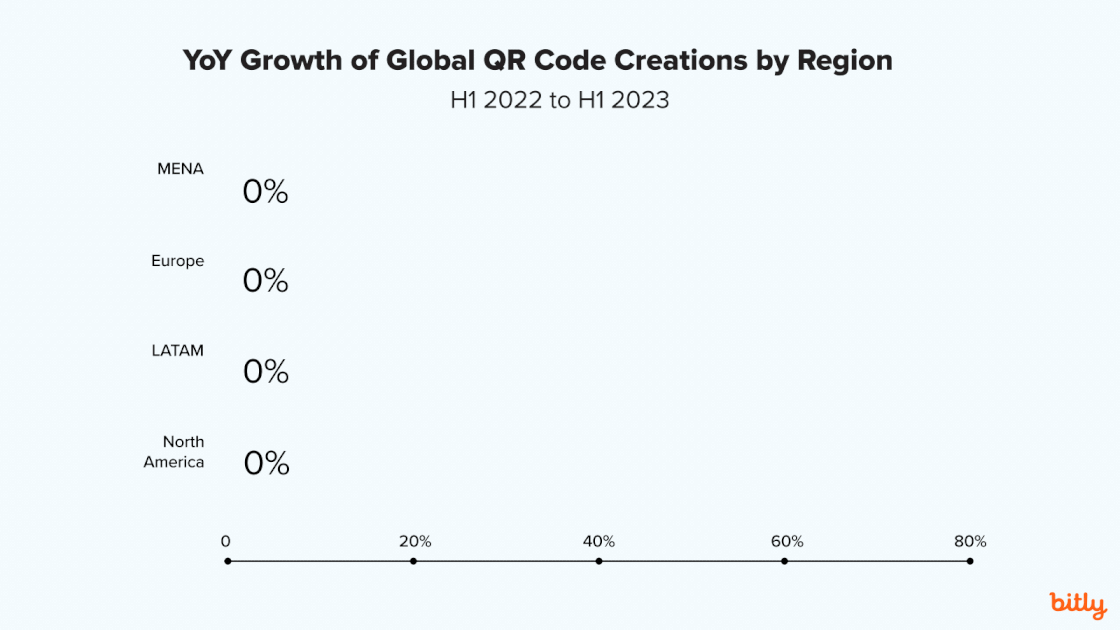
Trend 2: QR Codes fuel digital experiences across industries
QR Codes are crossing industry lines as the importance of creating branded and measurable digital experiences grows.
There’s no denying that the COVID-19 global pandemic boosted QR Code usage as industries were faced with the need to accommodate a touchless world, but as restrictions eased over the past few years, we’re not seeing creations slow down. In fact, businesses and brands are using QR Codes to do more than simply share a link—they’re generating curiosity, engaging with consumers, and doubling down on what works by measuring QR Code performance.
Breaking down QR Code creations by industry also paints an interesting picture as we see innovative use cases emerge. From the first half of 2022 to 2023, we see significant expansion within the Restaurant and Leisure industry with 187% growth in QR Code creations.
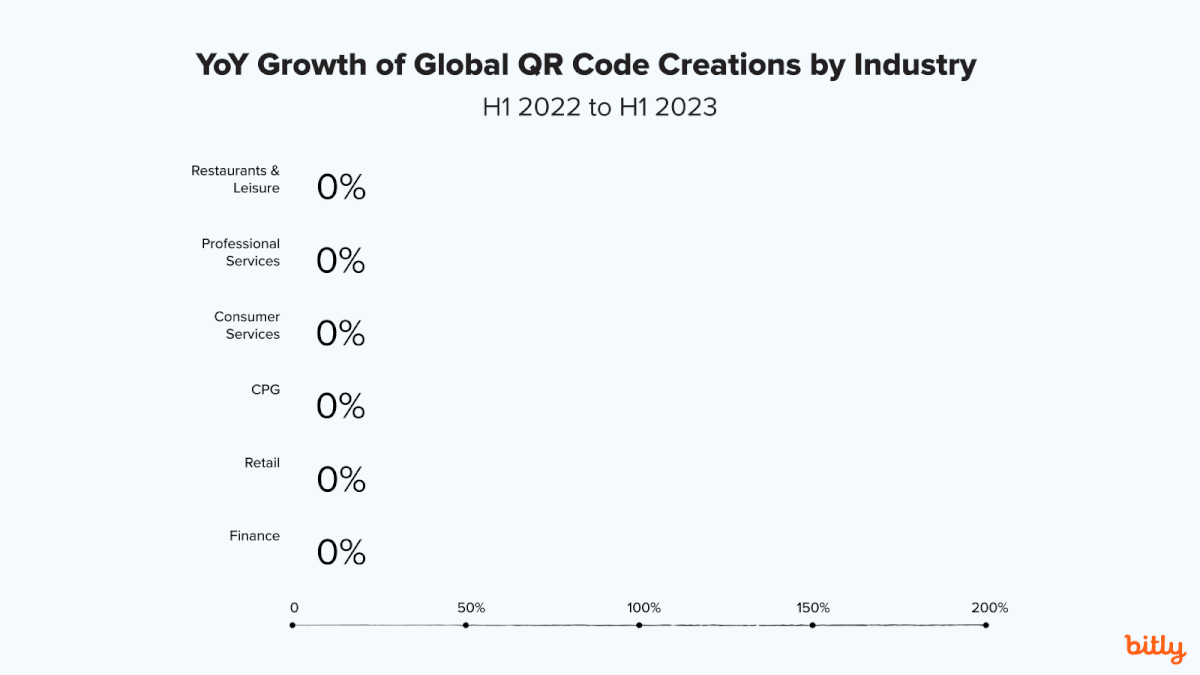
And while some restaurants may shift back to the use of physical menus, the opportunity to further engage patrons with QR Codes extends across a number of customer touchpoints. Restaurants are using QR Codes creatively to give customers a way to unlock special rewards, join newsletters, learn more about the history of the establishment, and create experiences that extend far beyond just ordering food.
The Restaurant and Leisure industry leads the pack with QR Code usage reaching 187% growth year-over-year.
The Professional Services industry is surging with 169% growth compared to the previous year. From streamlining communications and making office check-ins easy to collecting valuable customer feedback, QR Codes are making consumer engagement fast and effective.
Over the past year, the Consumer Services industry also saw a 120% increase in year-over-year growth, as people have grown accustomed to gaining entry to events, providing payment, and accessing loyalty programs through QR Codes.
We’re also seeing notable growth in QR Code creations in both the Retail and Consumer Packaged Goods (CPG) industries at 88% year-over-year. This boost in QR Code usage highlights a deepened investment in enhancing customer experiences through the use of QR Codes on product packaging, enabling a seamless flow of information between brands and customers.
Lastly, the Finance industry experienced an 87% growth in QR Code creations when compared to the first half of 2022. Whether customers are visiting banks in person or downloading apps on their mobile devices, QR Codes are transforming the traditional banking experience into a far more interactive one.
Spotlight on QR Code Innovation: Retail and CPG Industries
According to GS1 US, a member of the GS1 Global not-for-profit organization that develops and maintains global standards for barcodes, the retail industry is undergoing a vast transformation with its shift from the use of traditional UPC barcodes to 2D barcodes on product packaging. The standards body is working with the industry to facilitate the transition to 2D barcodes, such as QR Codes, that can embed the GS1 Digital Link standard to Web-enable barcodes, by 2027.
This evolution within the retail industry presents a massive opportunity for businesses to connect with consumers wherever they are and on the customer’s terms. Brands and retailers are already leveraging QR Codes to share sourcing information about products, offer loyalty points, coupons, and special offers, and promote enhanced digital content experiences. Over the next several years as QR Codes continue to become the standard within the Retail and Consumer Packaged Goods industries, we expect to see sustained growth and innovation.
“The way in which we interact with products has changed—and industry and technology have to keep up. GS1 US is collaborating with stakeholders, including brands, retailers, and solution providers, on a transition plan dubbed “Sunrise 2027”, which will aid the industry in moving toward a single, standardized barcode on pack that can carry more data. The result will be more efficiencies for businesses and trading partners as well as increased consumer engagement via product packaging and satisfaction.”
– Gena Morgan, Vice-President, Standards, GS1 US
We were also curious to see how businesses across industries are customizing their QR Codes for better integration into their materials and stronger brand alignment. We looked back at frame color selections over the past several years to uncover which colors were most popular. Grey and black are among the most popular colors, with blue, green, and red following on as top selections.
Creating branded experiences is a top priority as the usage and application of QR Codes evolve over time.
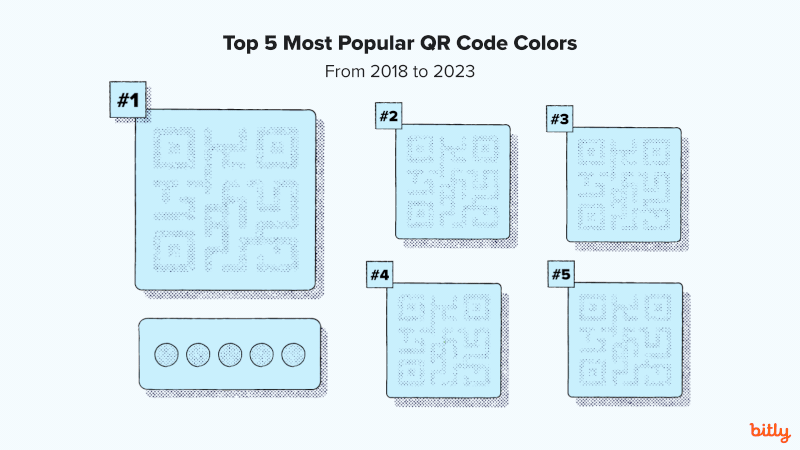
As businesses and brands develop innovative ways to engage customers with QR Codes, they’re maintaining brand consistency and customizing their creations to suit different contexts. Recently, we’ve seen an explosion in creativity with the rise of generative AI, inspiring creators to turn traditional QR Codes into beautiful works of art.
Trend 3: Businesses are embracing QR Codes in the face of change
Faced with economic uncertainty, small and medium-sized businesses are embracing technology and adapting to changes in consumer behavior.
Since the first half of 2022, economic concern and the persistent threat of inflation looms for businesses of all sizes across industries. And while providing the best possible experience for customers has always been important, brands and businesses are now tasked with maintaining a loyal customer base while driving more awareness to bring in new revenue.
With the need to stay competitive and maintain customer loyalty, businesses of all sizes are increasingly embracing QR Codes to enhance customer experiences and boost brand loyalty. Because QR Codes are able to facilitate instant connections with customers, businesses can activate more touchpoints across the customer journey in a way that’s effective, versatile, and measurable.
Whether it’s scanning a QR Code on a product to access detailed ingredient information or redeeming a discount coupon by scanning a code at checkout, QR Codes are enabling businesses to create more personalized and convenient digital experiences. According to our data, companies of all sizes are increasing their use of QR Codes in the first half of 2023, with over 140% growth in QR Code creations across the board compared to the same period in 2022.
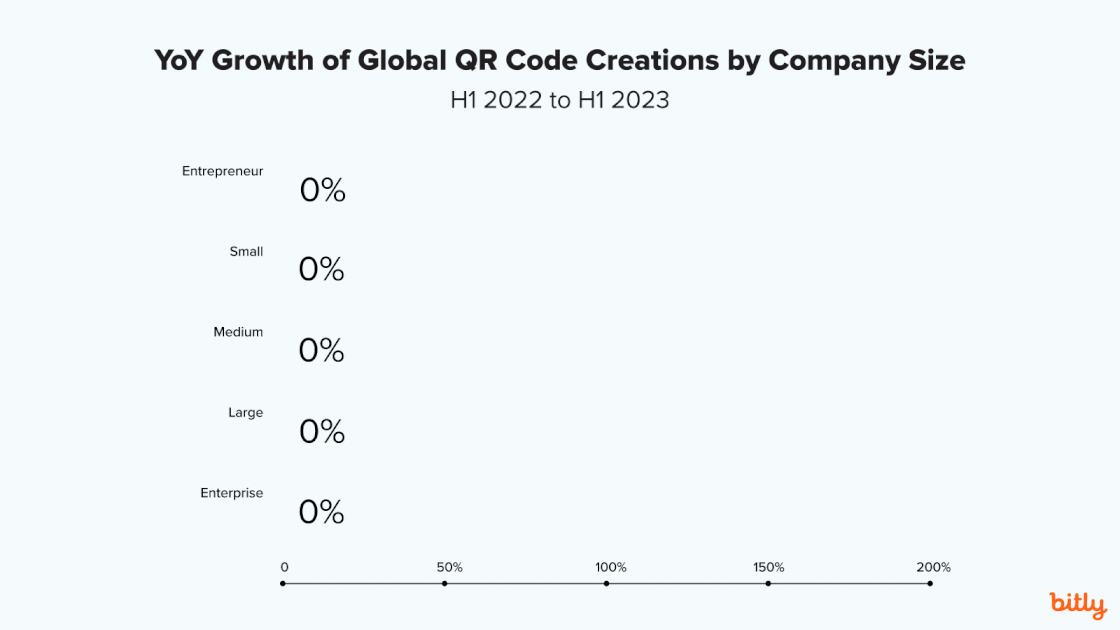
QR Code creations across companies of all sizes are growing at over 140% when compared to the same period in 2022.
This growth indicates a widespread recognition of QR Codes as a versatile tool for enhancing brand experiences and improving customer engagement across various company sizes. And while we know businesses are invested in leveraging QR Codes, we also wanted to take a look at how consumers are actually interacting with them over time.
Since 2018, we’re seeing a steady increase in global QR Code scans by people around the world. Looking back at the past several years, we see a surge in scans during the global pandemic, with a 326% increase in scans in 2021 compared to the same period the previous year. QR Codes became the go-to solution for contactless interactions throughout the pandemic, and their global usage extends far into 2023.
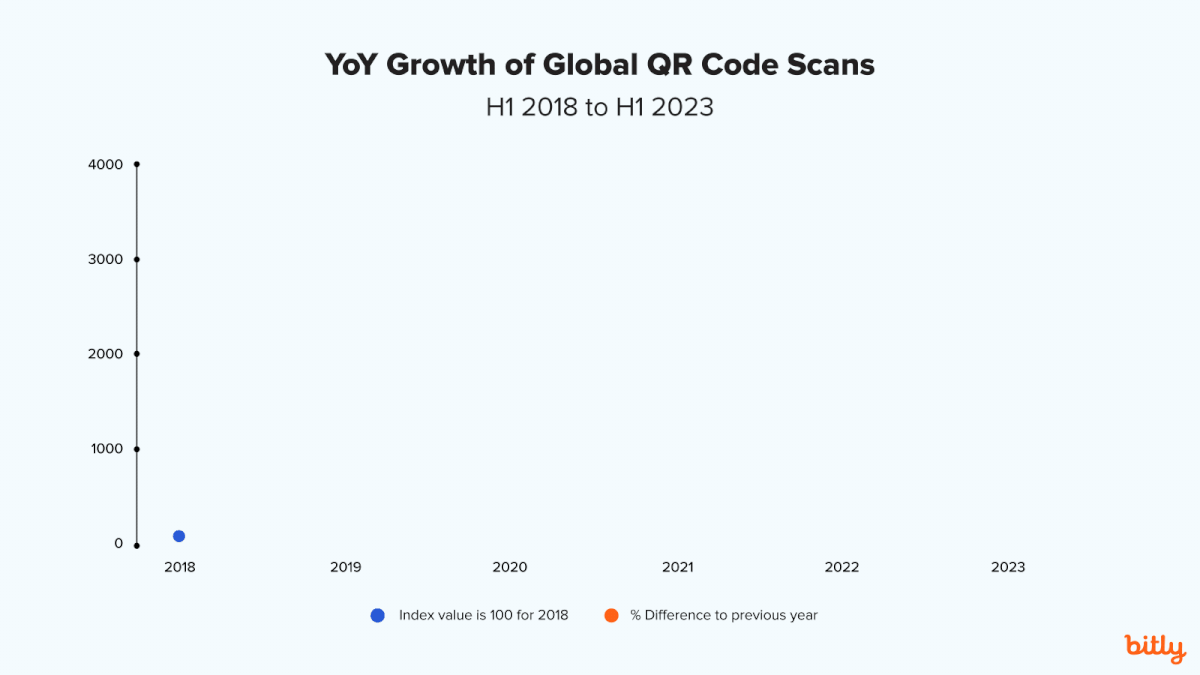
And while the growth rate for scans slowed down in 2022 and 2023, the absolute number of QR Code scans is still increasing over time, indicating sustained and ongoing usage.
QR Codes are continuing to endure globally after the pandemic made the masses aware of their convenience and versatility.
See QR Codes in Action
In pursuit of widespread recognition in a people’s choice craft beer competition, Modus Brewing leveraged Bitly QR Codes to engage their customer base and secure votes for their Mexican-style lager, Modus Cerveza. Sam Evans, Modus Brewing’s Digital Marketing Manager, knew that amidst stiff competition from hundreds of breweries and thousands of nominated beers across Australia, standing out and encouraging participation from their patrons was going to be key to success.
By strategically incorporating Bitly QR Codes on beer cans, product packaging, and even on posters hung on the brewery’s walls, Modus Brewing effectively amplified its promotional campaign and turned over 16,000 scans into an award-winning beer. Thanks to the power of QR Codes (and their incredible beer), Modus Brewing ranked #30 on the competition’s list, cementing its position as a noteworthy and respected brewery nationwide.
“We had QR Codes on every bit of point of sale that we printed out. Is a specific poster working? Is a refrigerator sticker working? We could keep track on a very granular level.”
– Sam Evans, Digital Marketing Manager, Modus Brewing
Read their story.
Trend 4: The ubiquity of QR Codes drives new connection opportunities
QR Codes are making their way to mainstream consumer experiences, creating more opportunities for businesses to connect directly with customers.
Over the past year, QR Codes have become pervasive, popping up in our homes on the products we buy and even on our television screens. From cereal boxes to prime-time commercials, QR Codes are now a clear staple for engaging audiences and consumers around the world, proving they’re not just an exciting new trend—they’re here to stay.
With their power to spark more user-initiated interactions, we’re seeing creative QR Code use cases emerge as brands and businesses focus on cementing customer loyalty over time. The links that power each QR Code can be tailored to suit any environment, making them ripe for personalization and customization.
Powering QR Codes with links to content-rich destinations will help businesses stand out and drive more engagement.
Businesses are now able to create more entry points for engagement as their QR Codes point to content-rich microsites, directing customers toward more immersive content experiences featuring everything from tutorial videos to detailed product ingredient information.
Spotlight on QR Code Innovation: Consumer Packaged Goods
Beverage brand Sprite is appealing to Gen Z and Millennials in a new campaign that celebrates the 50th anniversary of hip-hop music—and they’re using QR Codes to encourage engagement. To drive consumers to its website, the brand is using QR Codes on packs of Sprite to drive consumers to exclusive content, merchandise, and event experiences featuring artists like Nas, Rakim, Latto, and GloRilla.
According to Sprite’s Director of Creative Strategy, A.P. Chaney, who was recently interviewed by Digiday, “We’re always reviewing and seeing how our consumers consume media, and that’s inherently where we would like to show up.” Chaney added, “We wanted something that consumers know how to use, that can react to, and get into our interface and be able to interact with all of our drops,” said Chaney, noting that QR Codes are becoming more accessible.
Digiday reports that Sprite has been exploring new ways to engage consumers with packaging since earlier this year. Sprite’s use of QR Codes showcases the growing recognition of their value as a marketing tool.
“We’re leaning into where our consumers are and creating content based on their behaviors and what we believe resonate with them.”
– A.P. Chaney, Director of Creative Strategy, Sprite & Fanta
Chaney, A.P. “Sprite tries to reach Gen Z, millennials with QR codes, social
spend honoring hip-hop’s 50th anniversary.” Digiday, June 27, 2023
When looking at the fastest growing Dynamic QR Code experiences in the first half of 2023 compared to the same period the year prior, top experiences include virtual business cards, QR Codes with changeable URLs, and feedback pages.
Through the use of virtual business cards, businesses can make instant, direct connections with customers. And with feedback pages, they’re able to collect valuable information through surveys and tailored questions that can be implemented to improve the overall customer experience.
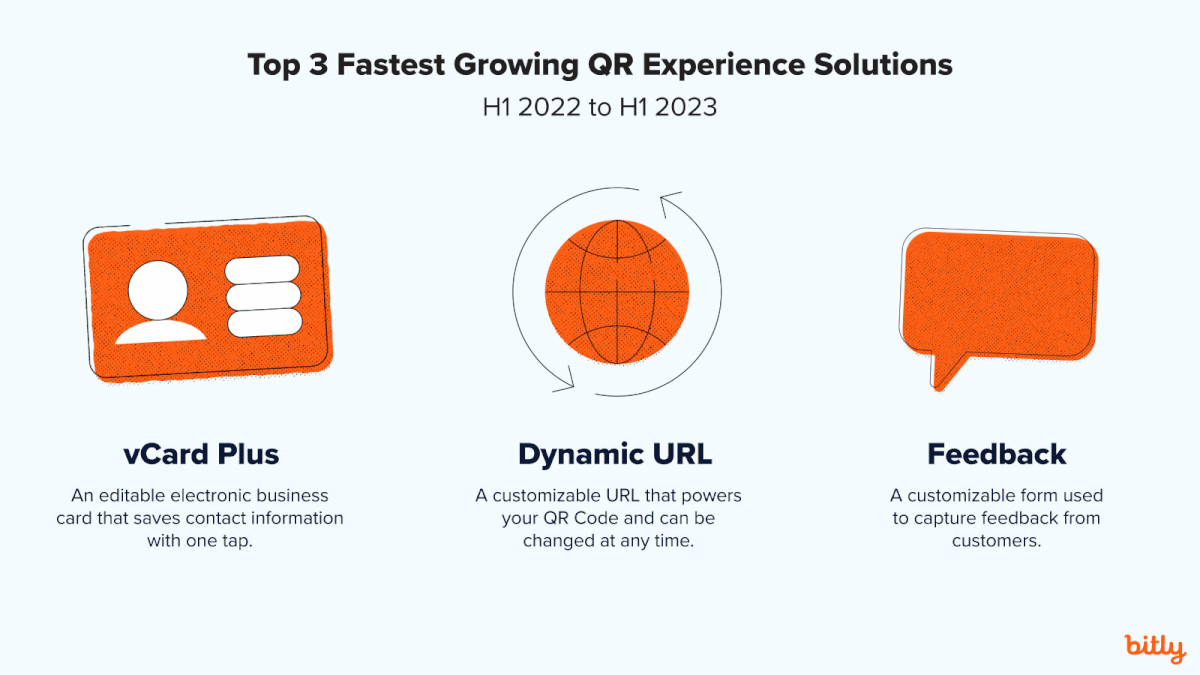
As we look into the fastest growing QR Code experiences across both Dynamic and Static QR Code types, we found that Wi-Fi QR Codes are experiencing substantial growth with a 96% increase in creations compared to the year prior. In addition, usage of Instagram QR Codes grew by an average increase of 35% month-over-month since the new experience was released in January of 2023.
Knowing that businesses are invested in driving more direct and interactive experiences with consumers, we also wanted to take a look at which industries are experiencing the strongest growth in QR Code scans compared to last year.
According to our data, the Finance, Software & IT, Consumer Products, Professional Services, and Government sectors are seeing the fastest growth in QR Code scans. With the rise in 2D barcodes being used on product packaging throughout the Consumer Products industry, we expect to see a steady increase in scan growth over the coming years.
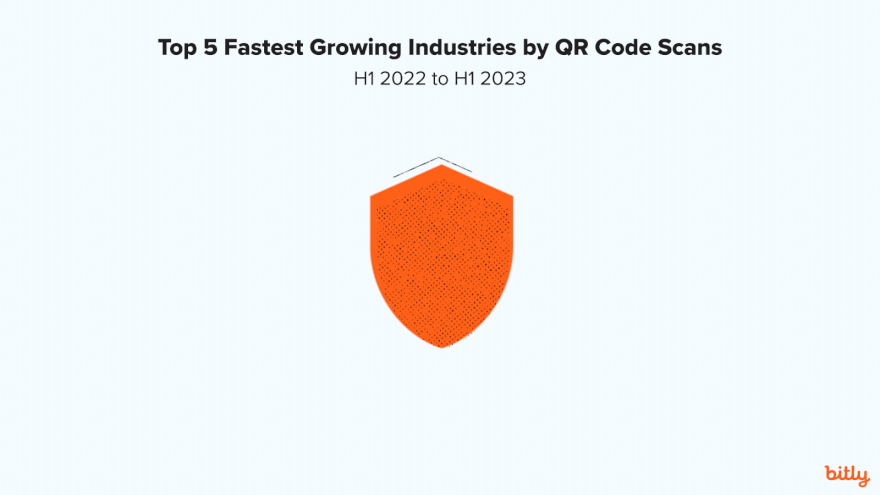
Because QR Codes are highly measurable, businesses can better understand audience engagement preferences.
The use cases for QR Codes across the Finance industry are also varied, from facilitating mobile payments to promoting special offers and personalized financial services across integrated campaigns. Software & IT customers are scanning QR Codes to download apps and learn more detailed information about the products and services they’re using, making experiences more streamlined for all.
Key Takeaways
- QR Codes are increasingly being adopted by businesses and brands to bridge the gap between the in-person and online worlds, with usage up 41% from last year.
- QR Code creations in the Middle East and North Africa region surged by 66% compared to the same period in 2022 as QR Codes gain momentum around the world.
- The Restaurant and Leisure industry shows no signs of slowing down its usage of QR Codes with 187% growth in QR Code Creations year-over-year.
- With QR Code creations up 88% from 2022 for both Retail and CPG industries, we expect usage to continue to grow as 2D Codes become the norm for product packaging.
- Businesses are leveraging the versatility of QR Codes to extend their brand as they explore innovative use cases and create unique, customized designs.
- QR Code creations across companies of all sizes are growing at over 140% year-over-year when compared to the same period in 2022.
- Small and medium-sized businesses are embracing QR Codes to offer value-added services and improve customer engagement in uncertain economic times.
- QR Code creations increased significantly for small businesses (175%) and medium-sized businesses (184%) in 2023 compared to 2022.
- Leading industries in terms of QR Code scans by consumers include Finance, Software & IT, Consumer Products, Professional Services, and Government sectors.
- Forward-thinking brands will invest in creating immersive brand storytelling experiences through the use of QR Codes that point to interactive content destinations.
Conclusion
Every QR Code scan holds the power to make a lasting impact on your audience, so it’s essential to embrace these emerging trends and stay ahead of the curve as the application of QR Codes becomes more sophisticated.
Successful businesses are creating more interactive and engaging experiences for their customers to foster brand loyalty and ignite meaningful, measurable connections. Stay on top of these trends so you can shape what it means to connect with your customers in 2023 and beyond.
About Bitly
Bitly is the world’s leading Connections Platform, providing a way for brands and businesses to build more meaningful connections with their audiences both online and offline. Shorten and customize links, create QR Codes, curate your Bitly Link-in-bio, and track performance all in one place. Feeling inspired to learn more? Get started today.




